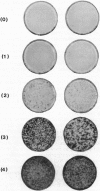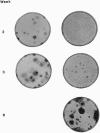Abstract
Early passages of NIH 3T3 cells yield about 10 transformed foci for every 10(5) cells seeded after the cells multiply to confluence in a standardized 2-week assay. The question arose whether more cells would give rise to foci if given more time for their development. This question could not be answered simply by extending the incubation period, since the original foci spread to cover much of the area of the culture dish. Transformed cells can also detach into the medium from the original foci to initiate new foci by reattaching at a distance. These problems were averted by growing cells in multiwell plates which in effect simulated partitioned culture dishes. All the wells in a given plate were assayed for focus formation at successive intervals up to 14 weeks. The results indicated the spatial pattern and sequence of transformation on different parts of the "partitioned" dish. The number of multiwells containing focus-forming cells increased steadily with time, indicating that all parts of a dish eventually undergo transformation. Also, most of the transformations were recorded long after confluence in the multiwells was reached. Hence such a transformation is much more likely to occur in the nondividing state rather than in the dividing state of the cells and is thus inconsistent with a mutational basis. The results suggest that "spontaneous" transformation is a population-wide, epigenetic phenomenon. This agrees with the results from clonal analysis and other studies and is well described by the concept of progressive state selection, in which "spontaneous" transformation represents a heterogeneous, adaptive response of competent cells to moderate constraints on cell growth.
Full text
PDF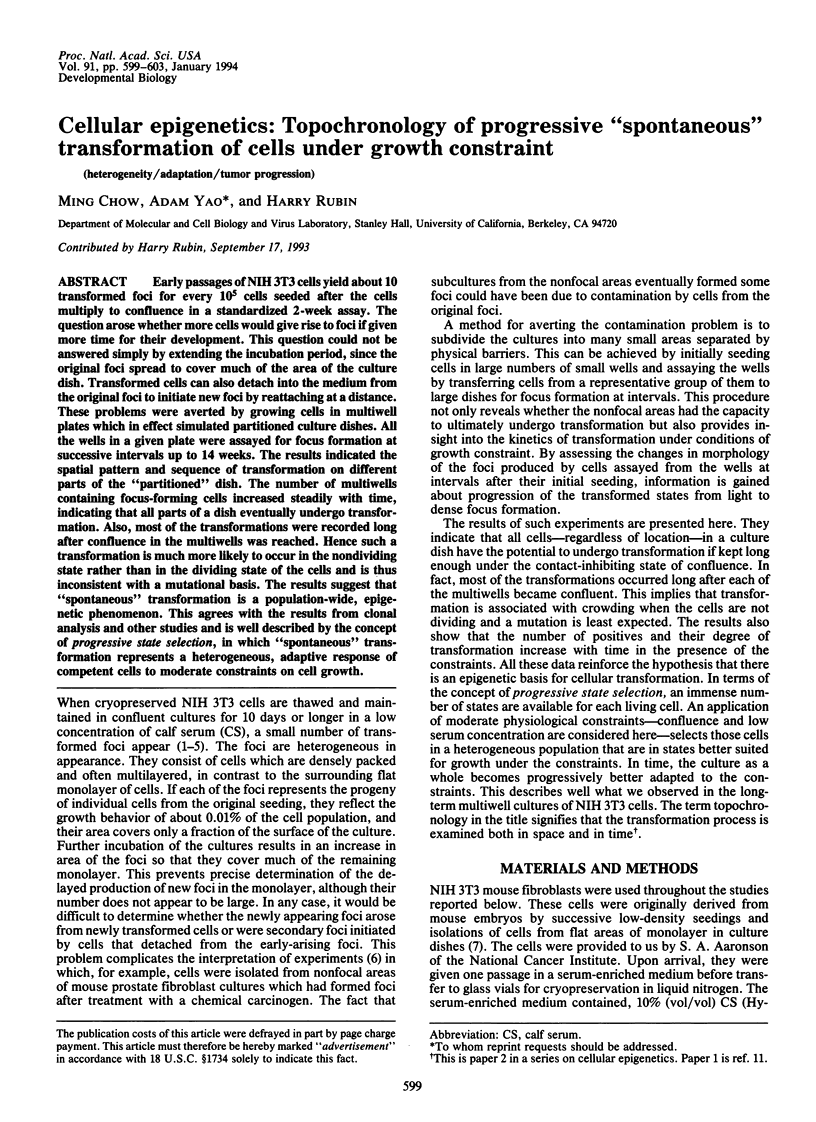
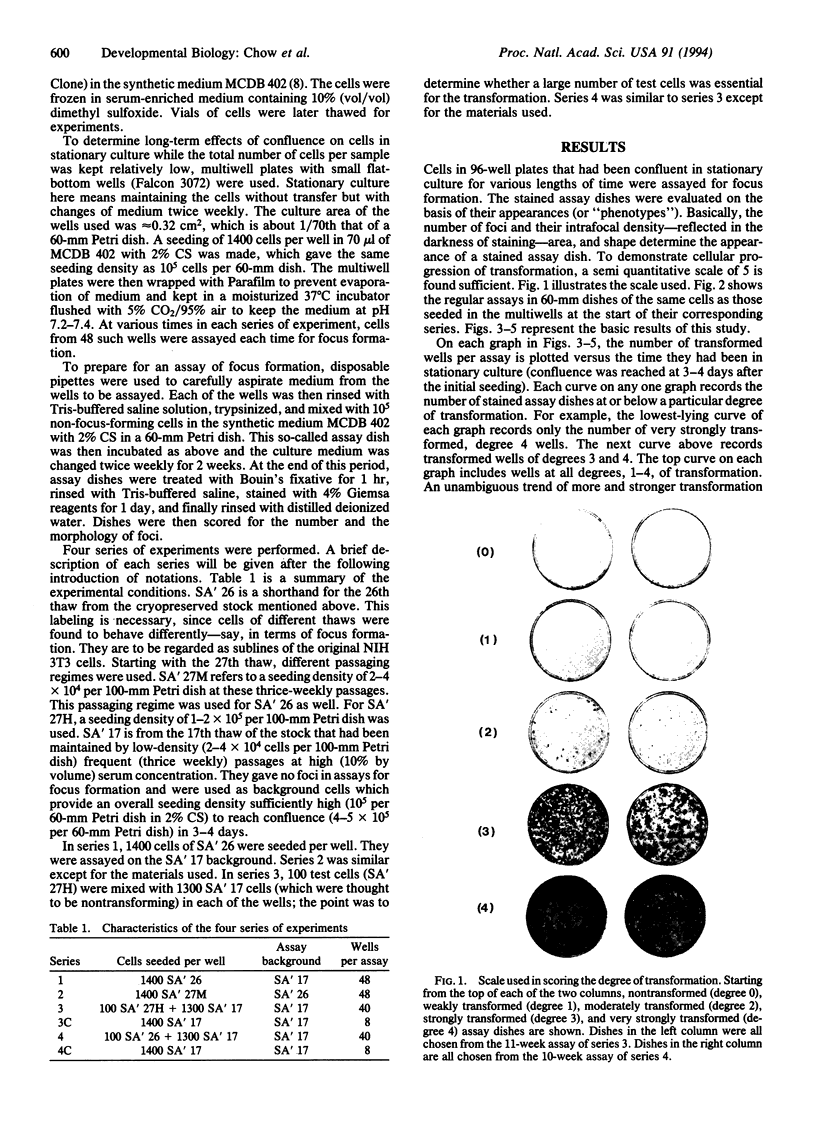
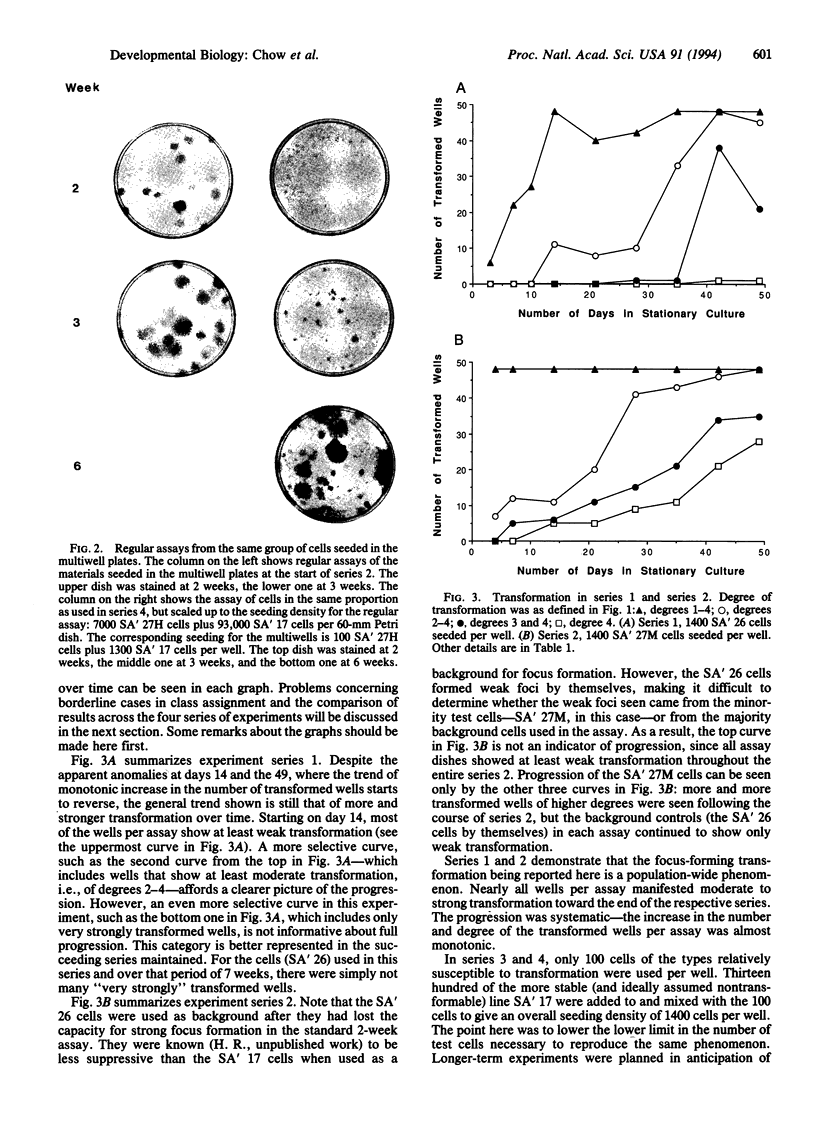
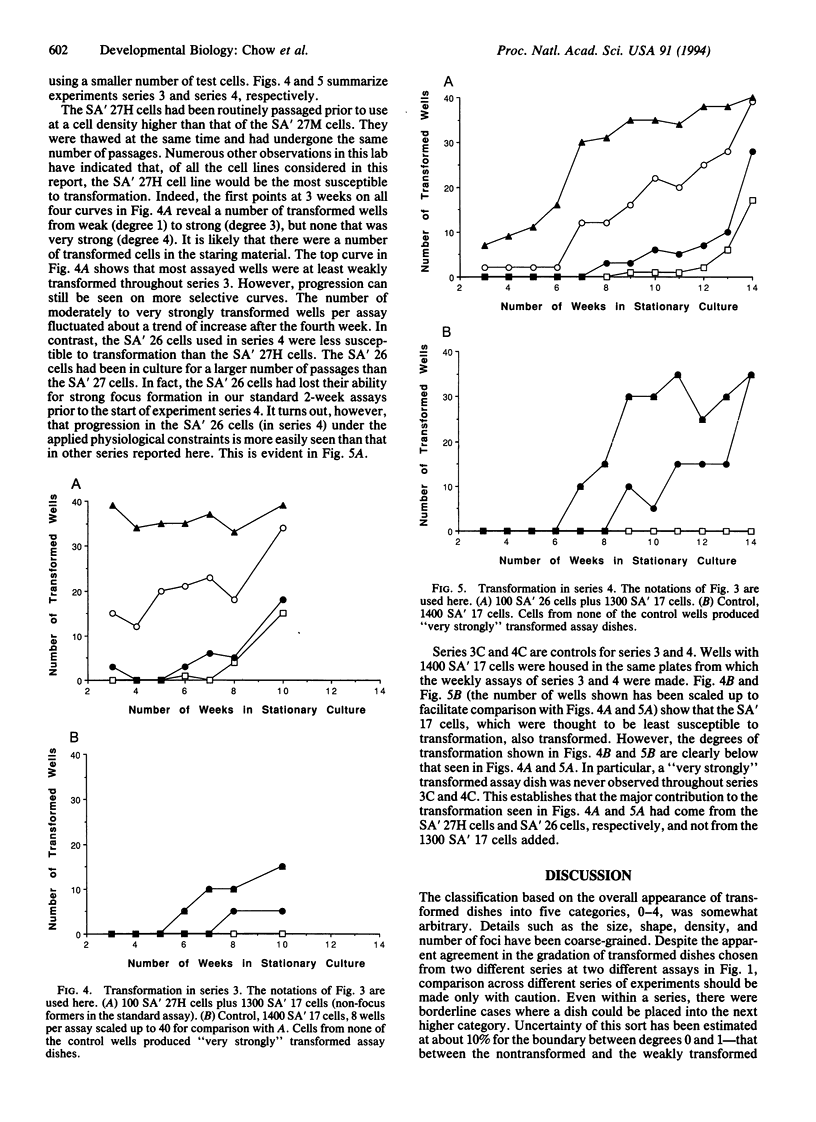
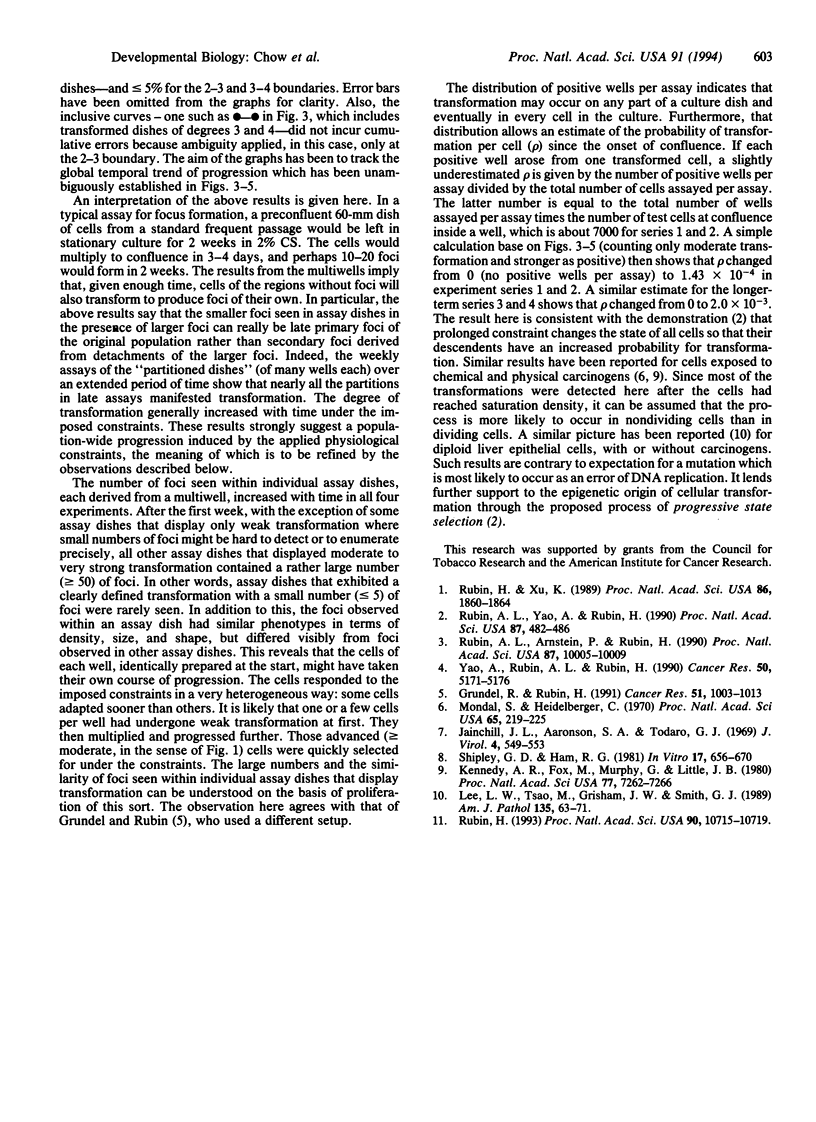
Images in this article
Selected References
These references are in PubMed. This may not be the complete list of references from this article.
- Grundel R., Rubin H. Effect of interclonal heterogeneity on the progressive, confluence-mediated acquisition of the focus-forming phenotype in NIH-3T3 populations. Cancer Res. 1991 Feb 1;51(3):1003–1013. [PubMed] [Google Scholar]
- Jainchill J. L., Aaronson S. A., Todaro G. J. Murine sarcoma and leukemia viruses: assay using clonal lines of contact-inhibited mouse cells. J Virol. 1969 Nov;4(5):549–553. doi: 10.1128/jvi.4.5.549-553.1969. [DOI] [PMC free article] [PubMed] [Google Scholar]
- Kennedy A. R., Fox M., Murphy G., Little J. B. Relationship between x-ray exposure and malignant transformation in C3H 10T1/2 cells. Proc Natl Acad Sci U S A. 1980 Dec;77(12):7262–7266. doi: 10.1073/pnas.77.12.7262. [DOI] [PMC free article] [PubMed] [Google Scholar]
- Lee L. W., Tsao M. S., Grisham J. W., Smith G. J. Emergence of neoplastic transformants spontaneously or after exposure to N-methyl-N'-nitro-N-nitrosoguanidine in populations of rat liver epithelial cells cultured under selective and nonselective conditions. Am J Pathol. 1989 Jul;135(1):63–71. [PMC free article] [PubMed] [Google Scholar]
- Mondal S., Heidelberger C. In vitro malignant transformation by methylcholanthrene of the progeny of single cells derived from C3H mouse prostate. Proc Natl Acad Sci U S A. 1970 Jan;65(1):219–225. doi: 10.1073/pnas.65.1.219. [DOI] [PMC free article] [PubMed] [Google Scholar]
- Rubin A. L., Arnstein P., Rubin H. Physiological induction and reversal of focus formation and tumorigenicity in NIH 3T3 cells. Proc Natl Acad Sci U S A. 1990 Dec;87(24):10005–10009. doi: 10.1073/pnas.87.24.10005. [DOI] [PMC free article] [PubMed] [Google Scholar]
- Rubin A. L., Yao A., Rubin H. Relation of spontaneous transformation in cell culture to adaptive growth and clonal heterogeneity. Proc Natl Acad Sci U S A. 1990 Jan;87(1):482–486. doi: 10.1073/pnas.87.1.482. [DOI] [PMC free article] [PubMed] [Google Scholar]
- Rubin H. Cellular epigenetics: effects of passage history on competence of cells for "spontaneous" transformation. Proc Natl Acad Sci U S A. 1993 Nov 15;90(22):10715–10719. doi: 10.1073/pnas.90.22.10715. [DOI] [PMC free article] [PubMed] [Google Scholar]
- Rubin H., Xu K. Evidence for the progressive and adaptive nature of spontaneous transformation in the NIH 3T3 cell line. Proc Natl Acad Sci U S A. 1989 Mar;86(6):1860–1864. doi: 10.1073/pnas.86.6.1860. [DOI] [PMC free article] [PubMed] [Google Scholar]
- Shipley G. D., Ham R. G. Improved medium and culture conditions for clonal growth with minimal serum protein and for enhanced serum-free survival of Swiss 3T3 cells. In Vitro. 1981 Aug;17(8):656–670. doi: 10.1007/BF02628401. [DOI] [PubMed] [Google Scholar]
- Yao A., Rubin A. L., Rubin H. Progressive state selection of cells in low serum promotes high density growth and neoplastic transformation in NIH 3T3 cells. Cancer Res. 1990 Aug 15;50(16):5171–5176. [PubMed] [Google Scholar]



